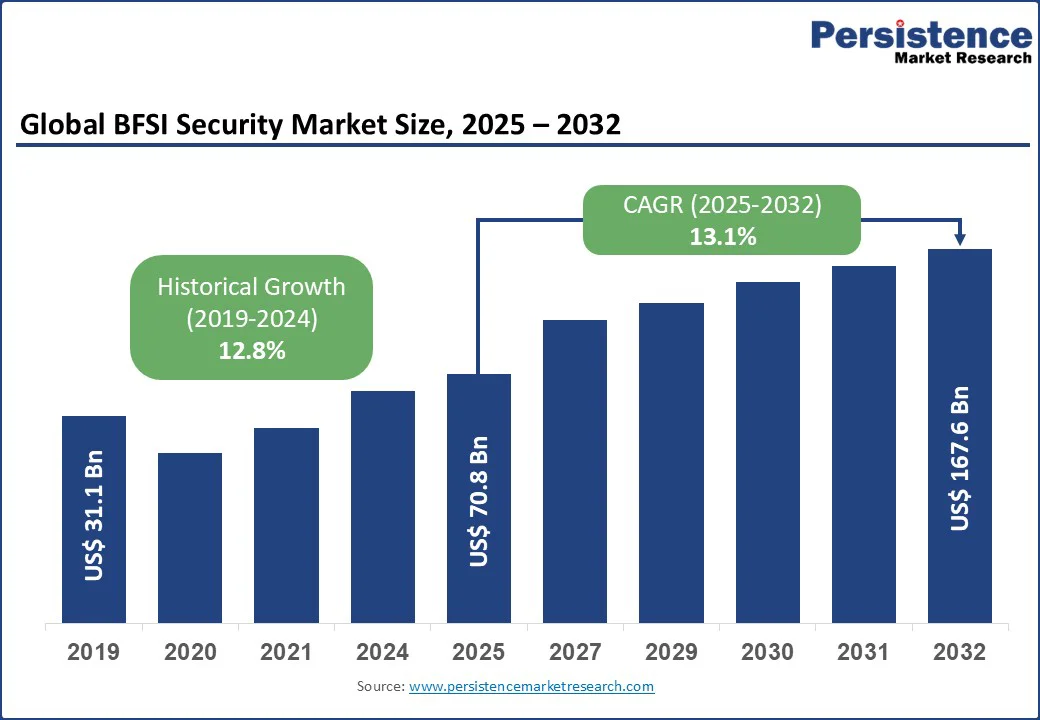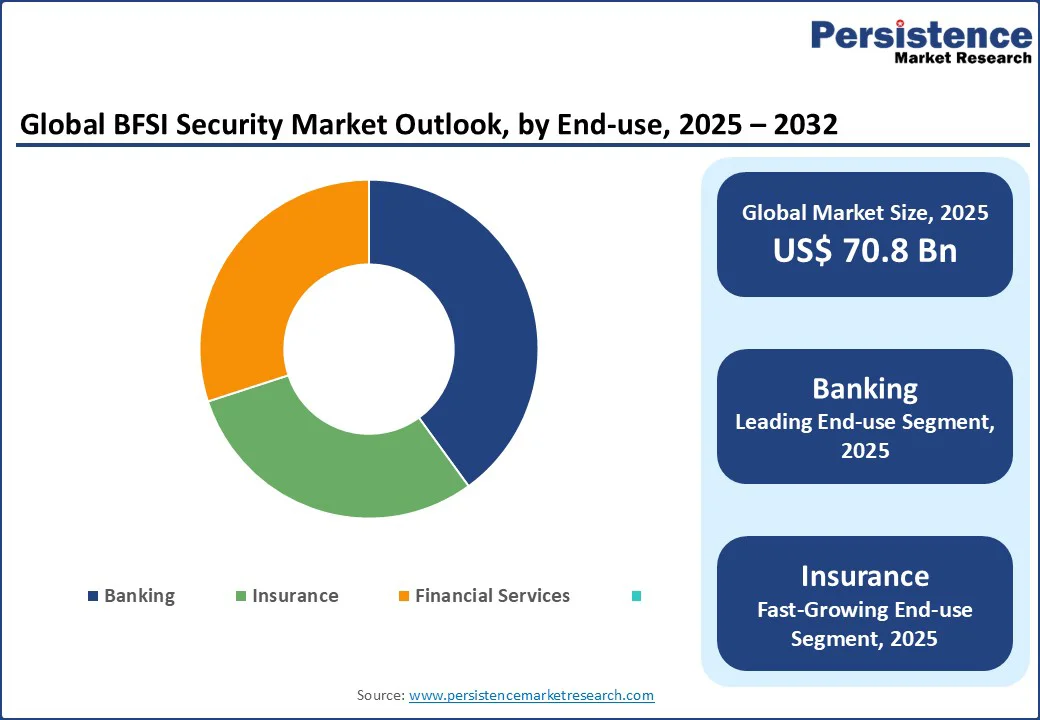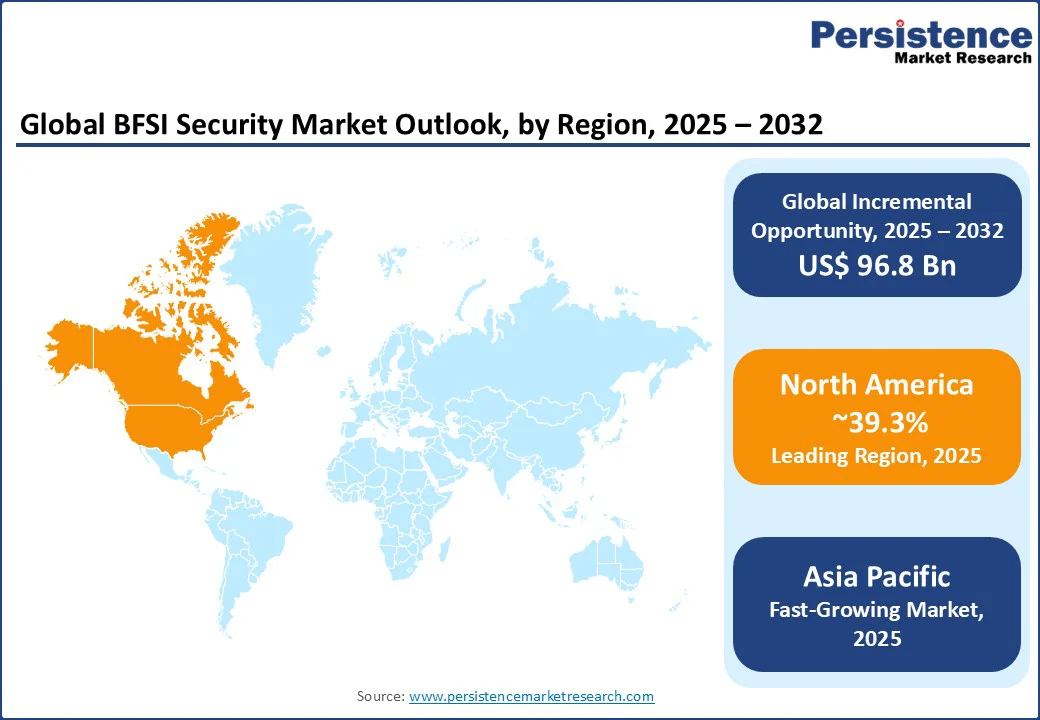ID: PMRREP10472| 189 Pages | 19 Sep 2025 | Format: PDF, Excel, PPT* | Banking, Financial Services, & Insurance (BFSI)

The global BFSI security market size is likely to be valued at US$ 70.8 Bn in 2025 and projected to reach US$ 167.6 Bn by 2032, growing at a CAGR of 13.1% during the forecast period from 2025 to 2032 driven by rise in cyber threats, rapid digital transformation, and stringent regulatory compliance requirements.
Banking security market trends highlight the adoption of advanced technologies such as artificial intelligence (AI), machine learning (ML), blockchain, and cloud-based security to combat sophisticated cyberattacks such as ransomware, phishing, and data breaches, which have surged by 60% across the globe after the pandemic.
Key Industry Highlights:

| Key Insights | Details |
|---|---|
| BFSI Security Market Size (2025E) | US$ 70.8 Bn |
| Market Value Forecast (2032F) | US$ 167.6 Bn |
| Projected Growth (CAGR 2025 to 2032) | 13.1% |
| Historical Market Growth (CAGR 2019 to 2024) | 12.8% |
The BFSI sector is a prime target for cybercriminals due to its handling of sensitive financial data, with global cybercrime losses in the financial industry reaching US$ 1.2 Bn in the U.S. In India, 429,847 cyber incidents were reported, with phishing and ransomware attacks growing by 60% globally.
Financial institutions face advanced threats such as zero-day exploits and deepfake fraud, necessitating robust Financial security solutions such as AI-driven threat detection and next-generation firewalls.
For example, IBM’s Guardium Insights, which uses ML to detect anomalies, reported a 30% adoption increase in global banks, while Palo Alto Networks’ Prisma Cloud saw a 25% sales surge in 2025 for securing cloud-based transactions.
Regulatory bodies, including the U.S. Securities and Exchange Commission (SEC) and India’s Reserve Bank, enforce stringent cybersecurity frameworks, driving a 35% increase in investments in encryption and IAM systems. The growing complexity of attacks, with 68% of financial firms reporting increased breach attempts, underscores the critical need for advanced security measures, fueling market growth.
Advanced financial security services solutions, such as AI-driven threat detection platforms and quantum-safe encryption systems, range from US$ 50,000 to US$ 500,000 per deployment, posing significant challenges for SMEs with limited budgets. Compliance with complex regulations such as GDPR and NYDFS Part 500 increases implementation costs by 20%, with certification processes delaying deployments by up to 12 months.
The global shortage of cybersecurity professionals, with a projected 35% demand increase by 2031, exacerbates implementation challenges, particularly in developing regions such as South Asia and Africa, where talent availability is limited by 40% compared to North America.
The integration of AI and blockchain in banking security presents transformative opportunities, with AI-driven cybersecurity spending projected to exceed US$ 20 Bn by 2025. AI platforms such as IBM’s QRadar SIEM reduce incident response times by 60%, while blockchain ensures secure, tamper-proof transactions, with 45% of Asia Pacific banks adopting.
These technologies create a US$ 10 Bn revenue opportunity by 2032, particularly in fraud detection and secure payment gateways. For example, FireEye’s Helix platform, integrating AI for threat intelligence, saw a 25% adoption increase in North American banks, while blockchain solutions from RSA Security are gaining traction in India’s fintech sector, driving a 30% growth in secure transaction systems.
Information security dominates the fintech security market, holding a 70.2% share in 2025. The segment’s leadership is driven by the critical need to protect sensitive financial data from cyber threats such as ransomware and phishing, which affected 68% of North American financial firms in 2025 (Verizon).
The segment’s growth is fueled by regulatory mandates such as GDPR, requiring data encryption, and the rising adoption of AI-driven threat detection, with IBM’s solutions deployed in 60% of top-tier banks.
Physical security is the fastest-growing segment. The segment’s growth is driven by advanced technologies such as biometric authentication and physical security information management (PSIM) systems, with Axis Communications reporting a 20% sales surge for surveillance solutions in bank branches and data centers in 2025.
Regulatory requirements for physical security, such as the U.S. Federal Reserve’s guidelines for bank premises and Europe’s ENISA standards, drive adoption, particularly in high-risk areas such as ATMs and vaults, where biometric systems have reduced unauthorized access by 25%.
Large enterprises dominate the banking security market, holding a 60.6% share in 2025, due to their vast data volumes and regulatory obligations. Compliance with regulations such as GLBA and GDPR, requiring annual audits, drives higher security spending, with large banks allocating US$ 100 Mn annually on average for cybersecurity.
SMEs are the fastest-growing segment, as they become prime targets for cyberattacks due to weaker security infrastructure. Cloud-based and managed security services, offered by Sophos and Trend Micro, have seen a 30% adoption increase among SMEs in Asia Pacific, driven by cost-effective solutions and government support, such as India’s INR 515 Cr cybersecurity investment in 2021.
Banking leads the financial security market, accounting for a 41.3% share in 2025, driven by high data sensitivity and regulatory compliance requirements. Regulatory mandates, such as the Reserve Bank of India’s cyber crisis management plans and the U.S. GLBA, drive demand for advanced security measures, with 90% of banks deploying SIEM systems.
Insurance is the fastest-growing segment, driven by increasing digitalization and fraud risks in claims processing. Regulatory mandates such as GDPR and the growing demand for cyber insurance, projected to reach US$ 20 Bn by 2025, further accelerate growth, particularly in Europe and North America.

North America dominates the fintech security market, holding a 39.3% market share in 2025, driven by its advanced financial infrastructure, stringent regulatory frameworks, and high incidence of cyberattacks. The U.S., accounting for 80% of the region’s market, invested US$ 10 Bn in cybersecurity for financial institutions in 2025, with 68% of firms increasing budgets due to a 50% rise in data breaches.
The Gramm-Leach-Bliley Act (GLBA) and NYDFS Part 500 mandate robust security measures, boosting demand for IBM’s Guardium Insights and Cisco’s Secure Firewall, with a 25% adoption increase in 2025.
The U.S. banking sector, handling 86.5% of digital transactions, drives demand for IAM and encryption solutions, with 70% of banks adopting cloud-native security. Canada’s Personal Information Protection and Electronic Documents Act (PIPEDA) fueled a 15% increase in biometric authentication adoption, with banks such as RBC deploying advanced access control systems.
The region is supported by early adoption of AI and blockchain technologies, with 60% of banks using AI-driven threat detection and 45% implementing blockchain for secure transactions. Innovations such as Palo Alto Networks’ Prisma Cloud, which reduces cloud vulnerabilities by 30%, further drive growth in North America’s BFSI security market.
Europe holds a 30% market share in 2025, led by Germany, France, and the U.K., driven by stringent data protection regulations and a mature financial sector.
Germany’s Federal Office for Information Security (BSI) enforces strict compliance, driving a 20% increase in IAM and encryption adoption, with Check Point Software’s Quantum Firewalls reporting a 25% sales surge in 2025. France’s financial sector, with €1 Bn invested in cybersecurity in 2025, fuels demand for Fortinet’s FortiSIEM solutions, particularly in Paris’s fintech hub, where 70% of startups adopt cloud security.
The EU’s General Data Protection Regulation (GDPR) and European Central Bank (ECB) guidelines mandate compliance, with 90% of banks deploying SIEM systems to meet audit requirements.
The region is driven by the growth of digital banking, with 65% of Europeans using online platforms in 2025, and innovations such as Sophos’ X-Ops endpoint security, reducing malware incidents by 20%. Germany’s focus on securing open banking APIs and France’s investments in smart city projects, integrating IoT security, further support market expansion, with 55% of European banks adopting AI-based threat detection.
Asia Pacific is the fastest-growing region, and a 25% market share in 2025, driven by rapid digitalization, increasing cyber threats, and government initiatives. China, with US$ 25 Bn in cybersecurity spending in 2025, faces 800 Mn daily cyberattacks, driving demand for Trend Micro’s Deep Security solutions, with a 30% adoption increase in 2025.
India’s Digital India initiative and INR 515 Cr investment boosts the adoption of McAfee’s MVISION Cloud by 35%, with 429,847 cyber incidents reported in 2025.
Singapore’s cybersecurity pledge and Japan’s quantum-safe cryptography pilots further accelerate growth, with 70% of banks adopting AI-based threat detection. The region’s rapid digital banking growth, with 45% of Indian businesses facing over 50% more cyberattacks, fuels demand for cloud-native and managed security services.
Japan’s focus on securing fintech, valued at US$ 8 Bn, and South Korea’s adoption of blockchain for secure transactions, with 50% of banks implementing it, drive the market’s expansion. Companies such as Fortinet and FireEye report a 20% sales increase in the Asia Pacific, supported by government-backed cybersecurity frameworks.

The global BFSI security market is highly competitive, with IBM Corporation, Cisco Systems, Inc., Palo Alto Networks, Check Point Software Technologies Ltd., McAfee, LLC, holding over 65% of the market share. Key players invest in R&D, with IBM allocating US$ 2 Bn for AI-driven security solutions such as QRadar SIEM.
Strategic partnerships, such as Cisco’s collaborations with global banks, enhance market penetration. Acquisitions, such as Fortinet’s purchase of a fraud detection startup in 2025, strengthen portfolios. Regional expansion, particularly in the Asia Pacific, and cloud-native solutions, such as Trend Micro’s Deep Security, ensure competitiveness, with 70% of solutions focusing on scalability and cost-efficiency.
The global BFSI security market is projected to reach US$ 70.8 Bn in 2025.
Rising cyber threats, rapid digital transformation, and stringent regulatory compliance drive market growth.
The BFSI security market is expected to grow at a CAGR of 13.1% from 2025 to 2032.
AI and blockchain adoption, along with cloud-based and managed security services, offer significant growth potential.
IBM Corporation, Cisco Systems, Palo Alto Networks, Fortinet, and Trend Micro are among the key players.
| Report Attribute | Details |
|---|---|
| Historical Data/Actuals | 2019 - 2024 |
| Forecast Period | 2025 - 2032 |
| Market Analysis | Value: US$ Bn, Volume: As Applicable |
| Geographical Coverage |
|
| Segmental Coverage |
|
| Competitive Analysis |
|
| Report Highlights |
|
By Product Type
By Enterprise Size
By End-use
By Region
Delivery Timelines
For more information on this report and its delivery timelines please get in touch with our sales team.
About Author